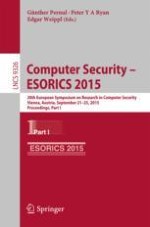2015 | Buch
Computer Security -- ESORICS 2015
20th European Symposium on Research in Computer Security, Vienna, Austria, September 21-25, 2015, Proceedings, Part I
herausgegeben von: Günther Pernul, Peter Y A Ryan, Edgar Weippl
Verlag: Springer International Publishing
Buchreihe : Lecture Notes in Computer Science
